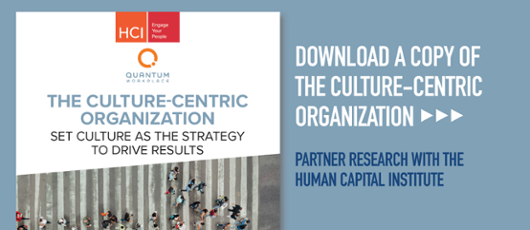Remote Work Culture: Redefining Company Culture in a Remote Work Environment
 Remote work environments are becoming the norm and many leaders are wondering how to build a company culture that resonates with remote and hybrid employees. But because remote work best practices aren’t clear yet to all leaders, employee engagement and retention is at risk.
Remote work environments are becoming the norm and many leaders are wondering how to build a company culture that resonates with remote and hybrid employees. But because remote work best practices aren’t clear yet to all leaders, employee engagement and retention is at risk.
Before the COVID-19 pandemic, only 7 percent of employees were completely remote. But during the pandemic, this changed as employees successfully worked from home. As a result, up to 95 percent of organizations are offering remote and hybrid options to their employees moving forward.
The high rate of remote and hybrid work that organizations continue to leverage proves that online environments are no longer the “new normal,” they are simply just normal.
But while employees’ lack of in-person connection often drives feelings of separation, adapting your culture to remote environments is key to employee, team, and business success.
What is remote work culture?
Culture is somewhat complicated. It can be defined simply as the way things get done, or it can be viewed as a multi-faceted system of objects, values, beliefs, norms, and behaviors. It outlines the accepted behaviors and attitudes that you want your employees to adopt.
Regardless of how your organization perceives culture, it shapes your employees’ day-to-day experience. Remote or not, company culture is important to focus on.
Leveraging a positive company culture has been a primary way that organizations have retained and recruited employees for years. But the company culture you’ve spent years building most likely won’t translate directly to a remote work environment. And this is an important and urgent challenge that is worth your organization’s resources.
A strong remote company culture helps employees stay connected and fosters the communication that builds trust. Plus, it helps employees feel seen, even as they work remotely. When your remote work company culture is prioritized, employees feel a sense of belonging. This helps them stay aligned with their organization to push business success.
Why is a strong remote work culture important?
While an organization’s offerings such as pay or benefits are important, a positive day-to-day experience is key to retention. By building a remote company culture that prioritizes your employees, you can increase engagement levels and alignment. And when employee morale is high, you can better attract and retain top talent who drive valuable outcomes.
To brand yourself as an employer of choice, prioritize creating a strong culture that’s built with remote and hybrid employees in mind.
10 best practices for building a remote work culture
1. Focus on the intent of your culture initiatives.
Leaders can’t just virtualize aspects of their company culture and expect the experience to resonate with all employees. Avoid translating in-person rituals to an online format without modification. Instead, think about the goal of your workplace culture initiatives and create ideas to accomplish that goal remotely.
For example, if one of your cultural rituals was to have an all-company lunch where employees had the opportunity to interact, a virtual lunch meeting probably won’t be the same experience. Instead, think about the intent of the original meeting. If your goal was to connect employees, ask yourself how you can create an experience with the same outcome for hybrid and remote workers.
2. Build time for casual conversation in meetings.
Allot time in your meeting agendas to allow for casual conversation. By leveraging casual conversation in meetings, coworkers can talk about their personal life happenings to boost connectivity.
Creating remote culture in teams helps employees feel valued on a small-scale level. And when team connections develop, employees feel cared about and are better aligned with their organization as a whole.
3. Create employee resource groups.
Employee resource groups are voluntary, employee-led groups that help employees feel connected with one another. These groups help bond people with similar interests or challenges.
Some examples include women’s networks, networks for working parents, and mental health advocacy groups. Seek input from employees and encourage those who are interested to create channels that connect them to others with similar interests.
4. Establish new norms.
It’s important for organizations to establish any new policies as employees work in a hybrid or remote setting. Ensure employees are aware of and can practice new remote work norms.
Keep expectations clear and consistent by communicating often. Don’t hesitate to demonstrate the desired behaviors you want your employees to adopt.
Consider leveraging tools that allow your employees to communicate often through a centralized platform. This helps teammates stay aligned to remain updated on new policies and procedures.
5. Build trust.
Trust is a key component of a healthy remote work company culture. Don’t assume that employees who work in remote environments are less productive. Give employees trust to avoid micromanaging and give them space to manage their workloads.
A great rule of thumb is to focus on the output of your employees rather than the amount of hours they spend online.
6. Leverage employee feedback.
To continuously listen and improve, organizations need to leverage employee feedback often. Because most organizations are new to the high amount of remote and hybrid employees, the process of managing them may not go perfectly at first.
That’s why asking for employee feedback often is key to ensuring you know what’s working and what isn’t. Leverage employee surveys that give you insight into the thoughts and perceptions of your employees. Don’t hesitate to gather feedback that helps you improve the remote and hybrid work experience for current and future employees.
7. Have 1-on-1s often.
Leaders should hold regular meetings with employees to build connections and establish trust. When you have more frequent contact with your employees, you can:
- Answer questions that arise
- Help employees avoid roadblocks
- Communicate your expectations
When leaders fail to conduct 1-on-1s, they risk losing alignment with their employees. Make 1-on-1s a priority to stay updated on your employees' performance and engagement levels.
8. Set clear goals and expectations.
Eliminate unnecessary barriers to productivity and employee engagement by ensuring that employees have clear goals and expectations.
Encourage employees to set SMART goals that align with the organization’s goals. This helps employees understand how their efforts contribute to business success.
9. Recognize employees for great work.
To make employees feel valued, empowered, and heard, ensure your leaders are recognizing their employees for positive results and progress. Recognition boosts employees’ awareness of your satisfaction with their performance.
Continue to reward hard work and correct behaviors. This helps increase your employees’ performance levels.
10. Create an effective onboarding process.
Creating a valuable onboarding process for remote employees can be difficult. But you can’t just virtualize your in person onboarding process and expect it to work in the remote work environment. Instead, design your onboarding process around the virtual experience. Develop processes that:
- Allow remote employees to shadow others
- Designate an outlet for remote employees to ask questions
- Create a network that enables remote employees to meet and build relationships naturally
While creating a strong company culture in a remote environment may seem daunting, there are practices to help you keep what’s important in mind. To streamline your culture initiatives, leverage software that lets teams collaborate, communicate, and elevate their work. When your leaders are aware of remote work best practices and have an effective platform to assist them, your company culture grows.
Ready to create a culture that drives results? Download your copy of The Culture Centric Organization.







